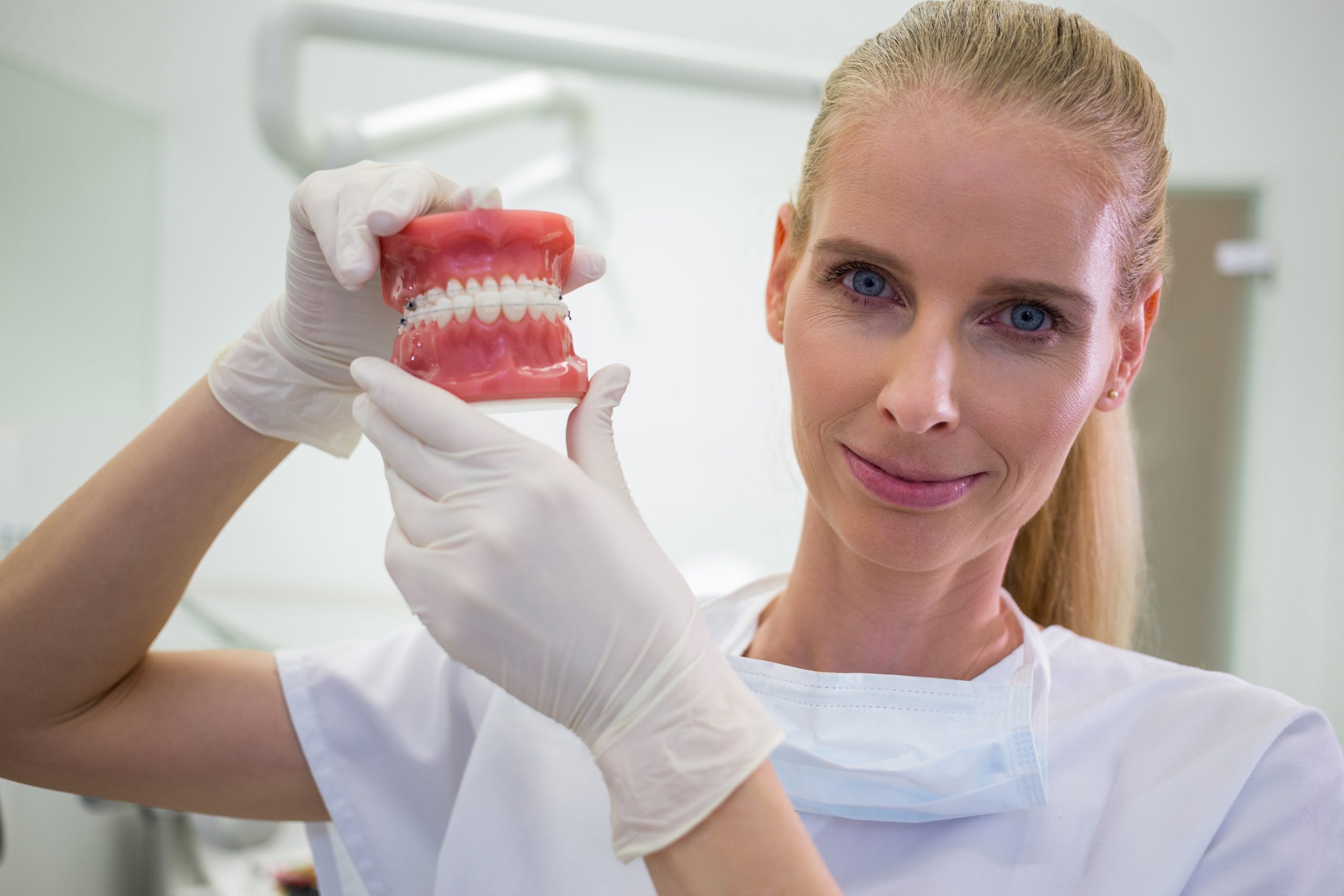Understanding the optimal timing for dentures after tooth extraction may enhance your comfort and oral health during the healing process. Healing after extraction is not instant—it’s a process that varies for each person. This guide helps explain the general stages involved without offering one-size-fits-all answers. Your dentist will recommend the most suitable timeline based on your recovery and needs.
Choosing when to begin wearing dentures depends on how your gums and bone respond to the healing process. The timing of denture placement affects fit, comfort, and long-term success, so patience is important. This article offers general advice to support informed discussions with your dental professional. Always follow your dentist’s personalised guidance to achieve the safest and most effective outcome.
Contents Navigation
- Summary of The Content
- What Happens Right After a Tooth Extraction
- Immediate Dentures—Can I Get Dentures Straight Away?
- How Long Should I Wait for Conventional Dentures?
- Factors That Influence Your Denture Timeline
- Interim Options During the Healing Period
- Denture Fittings and Adjustments Over Time
- Final Thoughts
Summary of The Content
- After tooth extraction, your gums and bone begin to heal, which is essential for a denture to fit properly.
- Healing continues over several months, with gums reshaping and jawbone density stabilising gradually.
- Some patients experience healing progress between three and six months after extraction.
- Immediate dentures offer temporary function after tooth extraction. These dentures require adjustments as the gums and bone settle during the recovery process.
- Conventional dentures are placed after several months to allow the gums and bone to stabilise for an improved long-term fit. Your dentist will evaluate healing progress to decide when you’re ready for this stage.
- Temporary options like flippers or partial dentures help maintain function and aesthetics during healing. These are short-term options that require follow-ups to maintain comfort and oral stability.
- Always follow your dentist’s advice during recovery. This can aid your healing and contribute to a better fit and function of your dentures.
What Happens Right After a Tooth Extraction
After a tooth extraction, your mouth begins a complex healing journey that affects short- and long-term outcomes. What you do during recovery plays a major role in how smoothly tissues and bone regenerate. Understanding the healing phases and your dentist’s aftercare guidance helps promote comfort, stability, and future denture success.
Healing Stages of Gums and Bone
After a tooth is removed, your body begins healing the surrounding gums and bone in a step-by-step process. In the first two weeks, soft tissue begins to close over the extraction site, and inflammation gradually reduces. Over the next four to six weeks, the gums strengthen and early bone healing occurs beneath the surface. This is a general guide; every patient’s healing timeframe may differ depending on their individual health and oral care.
Following that initial period, the underlying jawbone continues to change shape and density over several months. Most reshaping and stabilisation typically occurs between three to six months after the extraction. This slow remodelling helps the bone prepare for dentures with better fit and comfort. Always consult your dentist, as they will assess your healing progress and recommend next steps specific to your situation.
Following Your Dentist’s Aftercare Instructions
Following your dentist’s aftercare instructions plays an essential role in supporting the healing process after a tooth extraction. Here are ways these instructions can improve comfort, denture fit, and long-term oral health during your recovery:
- Keep the Extraction Site Clean:
Gently cleaning the area as instructed by your dentist helps prevent infection and promotes proper healing of the gums and bone. Avoid using harsh rinses or brushing the extraction site unless instructed to do so. - Follow Eating Guidelines to Protect Healing Tissue:
Consuming soft foods and avoiding chewing near the extraction site helps reduce pressure on the healing area. Your dentist may advise specific food types or textures to minimise discomfort and support tissue recovery. - Manage Discomfort Safely:
Only use pain relief medications recommended by your dentist or healthcare provider. Over-the-counter options can be helpful, but dosage and duration should be discussed to prevent complications or delays in healing. - Minimise Swelling:
Apply cold compresses and elevate your head when resting during the first 24–48 hours, as directed. These steps can ease inflammation and reduce the risk of delayed healing. - Attend All Scheduled Follow-Ups:
Post-operative checkups enable your dentist to assess your healing progress and identify any concerns that may impact your recovery. They use this information to plan appropriate next steps, such as denture fittings or adjustments tailored to your progress. Skipping appointments may lead to prolonged recovery. - Seek Help if Unusual Symptoms Occur:
If you experience prolonged bleeding, persistent pain, swelling, or signs of infection such as fever or pus, contact your dentist promptly. Early intervention can prevent further issues and contribute to a better long-term result. - Ask Questions About Your Personal Care Plan:
Your dentist understands your unique oral health history. If anything in your aftercare plan is unclear, ask for clarification so you can follow the recommendations with confidence.
Following your dentist’s instructions can reduce the risk of complications during the healing period after tooth extraction. This also supports a smoother recovery and helps improve the comfort and function of your future dentures.
Immediate Dentures—Can I Get Dentures Straight Away?
Immediate dentures offer a temporary option for individuals who want to maintain their smile after tooth extractions. They provide early aesthetic and functional support while the mouth adjusts to recent changes. However, they often require follow-up care as the gums and jaw naturally reshape during the healing process.
Pros of Immediate Dentures
Immediate dentures enable patients to leave the clinic with a smile, even after all their teeth have been removed. This treatment helps restore confidence during the early stages of healing after tooth extraction. Many patients find it easier to speak and eat during this time with temporary dentures in place. Immediate dentures act as a short-term option while the gums heal underneath.
These dentures provide aesthetic and functional benefits during the first few weeks following extraction. For many patients, not being without teeth during recovery supports their emotional and social well-being. Immediate dentures may temporarily maintain facial shape, but natural bone and gum changes can still occur after tooth loss. While not a long-term option, they can maintain facial structure while the mouth begins to heal.
Cons and Need for Adjustments
As the gums heal, their shape changes, causing the immediate dentures to lose their snug fit. This natural shrinking of gum tissue means that dentures may require adjustments to improve comfort and function. It’s common for denture patients to return for relining or even a replacement once healing is complete. These adjustments help maintain a proper fit and minimise irritation as the gums continue to heal.
Needing changes after receiving dentures immediately does not mean the treatment failed. It reflects how the healing process affects the shape of the jaw and soft tissue. Dentures involve multiple steps, and adjusting them helps achieve better long-term fit and function. Your dentist will assess when your gums are stable enough for conventional dentures or more stable options.
How Long Should I Wait for Conventional Dentures?
After tooth extraction, many patients must wait several months before receiving conventional dentures for optimal long-term fit and comfort. The healing process allows gum tissue and bone to stabilise, which helps dentures fit properly and function well. Typically, dentists recommend waiting around three to six months before placing conventional dentures after teeth are removed. This timeframe allows the gums to heal and the jaw to reshape, minimising the need for major adjustments later.
Waiting before getting dentures also helps avoid complications such as sore spots, a loose fit, or poor alignment with natural teeth. Immediate dentures are available, but they may require additional adjustments as the gums shrink during the initial healing period. Denture patients should expect regular follow-up appointments to support a more comfortable and stable fit for new dentures as the mouth heals.
Your dentist will assess the number of teeth that need to be removed, taking into account your oral health and bone structure. This helps determine the optimal time to proceed with the next stage of your denture treatment.
Factors That Influence Your Denture Timeline
Several factors influence the timing of denture placement after an extraction. Individual healing times vary depending on oral health, treatment complexity, and any additional surgical procedures that may be required. Understanding these factors helps set realistic expectations and contributes to a smoother path towards long-term denture success.
Number of Teeth Removed
When multiple teeth are removed, the healing process typically takes longer before dentures can be fitted comfortably. The more teeth pulled, the more time gums need to heal and reshape for dentures to fit properly. Healing after tooth extraction varies, especially when one or more teeth are lost in different areas of the mouth. Replacing missing teeth with dentures involves adjustments over time, particularly when the gums shrink after multiple extractions have been performed.
Bone Grafting or Other Procedures
Bone grafting may be required when tooth removal affects the jaw’s ability to support dentures securely. This procedure extends the healing period, but it helps promote long-term fit and stability of complete or partial dentures. Your dentist will assess your oral health and provide personalised advice regarding grafts, implants, or other necessary modifications. Each person’s situation is unique, and healing depends on factors such as age, health conditions, and the number of teeth being extracted.
Interim Options During the Healing Period
If you’re waiting to receive your custom dentures after tooth extraction, interim options can help maintain oral function during the healing period. Here’s what you need to know:
- Temporary Dentures Help Bridge the Gap:
Dentists may provide temporary dentures, such as flippers or acrylic partial dentures, while your gums heal and your jaw stabilises. These help restore appearance and support daily functions, such as speaking and chewing, after teeth are removed. - Flippers Offer a Light, Removable Option:
Flippers are lightweight partial dentures made from acrylic that replace one or more teeth. They’re designed for short-term use and help fill gaps caused by tooth removal, especially when appearance is a concern. - Temporary Options Are Not a Final Fit:
These false teeth are less durable and may not fit as securely as conventional dentures during the healing period. Expect necessary adjustments or relining if the product is used for several weeks. - They Assist Function But May Require Modifications:
While temporary dentures restore some functionality and aesthetics, they may cause soreness or irritation as the gums shrink. Dentists can adjust them to help improve comfort until you’re ready for custom-made or complete dentures. - Dentists Will Monitor Fit:
Follow-up appointments are essential to check how your gums are healing and to assess the stability of interim prosthetics. Follow-up care helps you maintain oral health and prepare for your dentures.
Some patients find interim options helpful during the healing stage after tooth removal or extraction. These options are temporary until custom dentures are fitted.
Denture Fittings and Adjustments Over Time
Getting a precise fit with dentures is a process that evolves as your mouth heals and changes. Taking careful steps, such as making impressions and making ongoing adjustments, helps maintain the comfort of your dentures. Regular dental visits are important for maintaining optimal oral health, including fit and function.
Taking Impressions After Healing
Once your gums and jawbone have healed, your dentist will begin the process of taking dental impressions. They’ll place soft impression material into a tray that fits over your gums. This material captures the exact shape of your mouth’s contours. These impressions help create dentures that sit more comfortably and function more effectively.
Accurate impressions are essential because they allow the lab to design dentures that match your unique oral anatomy. If the fit is too loose or tight, adjustments may affect comfort and chewing ability. Dentists often retake impressions if there are changes in gum shape. This careful approach helps achieve a secure and natural fit for your final dentures.
Relines and Adjustments
As gums naturally shrink and reshape after extractions, dentures may loosen and require adjustment to stay comfortable and effective. Dentists perform denture relines to improve the fit of the base against the changing contours of the gums. These relines can involve adding material inside the denture to enhance fit and stability. Regular reline appointments help patients maintain secure, functional dentures as healing continues over time.
Adjustments also involve reshaping pressure areas or trimming sections causing irritation or discomfort during wear. Dentists may make minor changes during checkup visits to support long-term oral function and comfort. These appointments are part of standard denture maintenance and vary depending on each person’s healing process. Following your dentist’s advice helps your dentures continue to fit properly and protect oral health.
Final Thoughts
Getting dentures after tooth extraction involves several stages that depend on how your gums and bone heal over time. Everyone’s healing timeline is different, so it’s essential not to compare your experience with others. Choosing the right time for dentures is essential for achieving long-term comfort, function, and stability. A dentist will guide your treatment based on your specific oral health needs.
At Karrinyup Dental Centre in Perth, we are here to guide you through every stage of your denture treatment. We take time to understand your goals and tailor your care accordingly. Dentures require professional planning to promote comfortable and functional outcomes. For advice and personalised care, book a consultation with our friendly dental team today!





